
MiG-29 Fulcrum (Novalogic)
Review, 1998 by Fausto Romeo
MiGMan thanks Fausto Romeo for this review which was actually one of the first additions to the Flight Sim Museum. All illustrations are by MiGMan.
❝
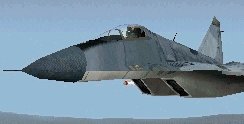
MiG-29 Fulcrum (Novalogic)

A MiG-29 flies over a Siberian airbase

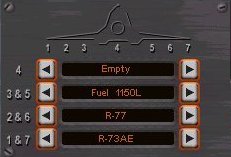

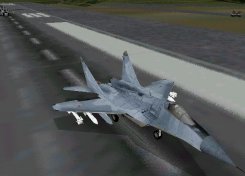
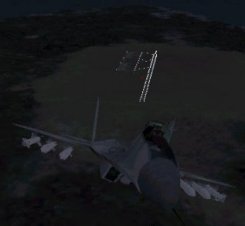
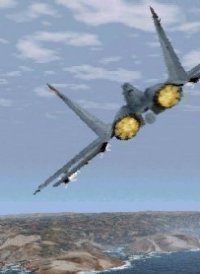
Both RD-33's running at 185%
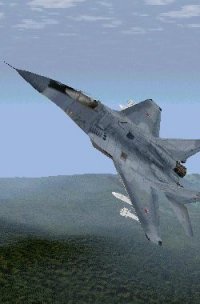
Flying at high alpha (Angle of Attack).
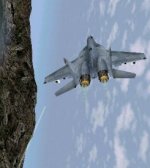
The wing root LERX stream vapour during tight turns.
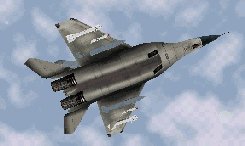
Press F9 for the special "Cobra View"
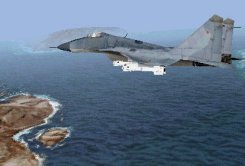
The MiG is very stall resistant in this sim
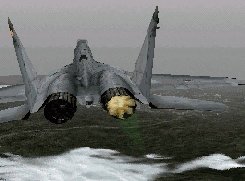
With proper application of rudder and stick, you can virtually "slide" around a wingtip.
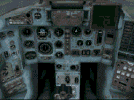
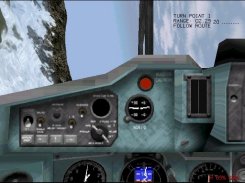
The combined AOA and G meter is a uniquely Soviet instrument.
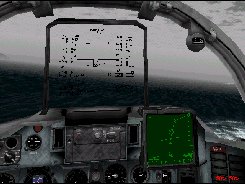
Padlock view

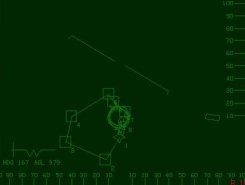
Bank indicator which turns in conjunction with the so-called watermark on the MiG
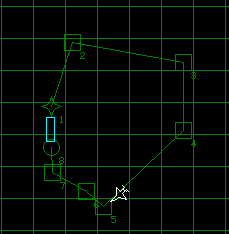
The radar scope doubles as a nav display.
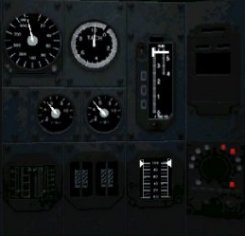
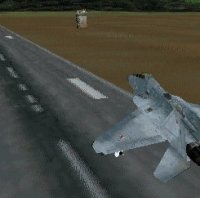
Coming in to land, perhaps a tad high? Better put the power back on, clean up and go around again.
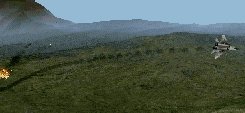
You can still see the flames at left as my MiG cops a hit to the right exhaust.
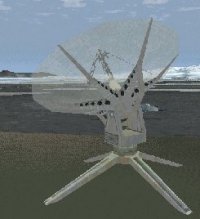
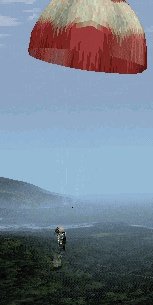
Practice your dogfighting or you'll be taking the SILK ELEVATOR!❞
While in a not too distant past flight simulations designed to run on a modest personal computer were severely limited by hardware and software constraints, contemporary flight simulators have a declared tendency to offer more and more realism to 'virtual top guns' and 'hard-core simmers'.
With the advent of increasingly powerful 3D engines, and with the widespread availability of 3D accelerator cards, modern PC flight simulations have reached graphical accuracy of mind-boggling proportions.
Flight simulation enthusiasts have evolved into much more than 'casual players', and are becoming increasingly informed and educated and hence more demanding.
Graphical excellence has had to be complemented with the development of realistic flight models, and with the implementation of sophisticated AI techniques. Realism has of course its drawbacks and pitfalls.
Are would-be-Top-Guns prepared to cope with encyclopedia - sized flight manuals riddled with technical jargon and countless abbreviations?

MiG-29 Fulcrum (Novalogic)
The other side of the coin is represented by the crucial issue of disclosure margin. Sure enough, the Cold War is over and there have been many beneficial spin-off effects of military technologies that have successfully made their way into the civil world. But let us not forget that anything touching upon the more specific aspects of any modern fighter jet may still be classified, and rightly so.
This is all the more true in the case of Soviet/Russian military technology and equipment which is still deployed by the armed forces of many countries around the globe. When I was in the US, for example, I heard more than one time people telling me that anything related to 4-th generation Russian fighters was 'no big deal', and that there was no reason for such material to be still classified.
To this assertion, I would like to reply that despite the difficult situation faced by Russia and all CIS republics, a lot of sensitive material that might lightheartedly be discounted as 'irrelevant' in the West, is in fact still of great military and technological relevance. To indiscriminately include it in a PC flight simulation would constitute an intolerable security leak, and a violation of state and military secrets.

A MiG-29 flies over a Siberian airbase
Loading the Sim
I received Novalogic's latest and eagerly awaited simulation in the last week of September (1998).
The package comprised both boxes containing the CD-ROM's necessary for the installation of the F-16 and MiG-29 modules, which have not been designed as stand-alone products, but which are meant to be used in conjunction with Novaworld; Novalogic's Integrated Battlespace, or IBS.
Along with the CD-ROM, each neatly packaged box contained a variety of additional items that are usually missing from mainstream military flight simulations, and which came as a much appreciated bonus: a high-quality plastified keyboard reference card, a keyboard key overlay pad, and even a MiG-29 / F-16 sticker!
We didn't get the sticker in Australia! - MiGMan
Installation was very straight forward, with the CD promptly loading the splash screen in autorun mode, and could take from a minimum of 100MB, to a maximum of 200MB of hard disk space for a full install.

Russian Language
The flight sim loads up rather fast, and after an exciting intro sequence beginning with with the Novalogic Logo, and ending up among MiG-29s roaring in the skies afterburners ablaze, the player is presented with a menu screen from which the various modules of the game can be accessed.
A quick glance at the configuration options is always recommended, although the program automatically optimizes game settings according to the type and quality of hardware being used. I chose a screen resolution of 800 by 600, alas with no 3D acceleration, which makes a HUGE difference in graphical detail and frame rate.
A very interesting feature that is implemented among the game settings is the ability to choose between English and Russian language voice dialogs, which I find absolutely marvellous!
This is probably the first-ever military flight sim to incorporate multi-language support, and also constitutes a very good reason to brush-up your Russian language skills. Back to the main menu, the 'overview' option starts a video sequence containing a brief explanation of the Fulcrum's performance, combat capabilities and history.
Ya gavaryu medlenno pa russki MiGMan
Weapons
But what are we waiting for, let's dazzle the crowd with some fancy manoeuvres!
Quick mission has it all, and enables the player to fire up those mighty RD-33 turbofans with a loud bang in no time, without having to go through the dangers and perils of a fully fledged campaign. Once inside the 'QUICK MISSION' module, have a quick look at the map just to check in what part of the world you will be showing off with those cobras and tailslides, and also to run through your assigned waypoints.
Clicking on the 'LOADOUT' button will take you to the hangar where the MiG-29 can be fitted with anything that might fit your offensive needs; from R-73Es to Kh-31s, the MiG's arsenal covers virtually every aspect of air-to-air and air-to-ground combat.
The only great absence from the game, and without doubt the Fulcrum's original and foremost air-to-air weapon is the R-27/AA-10 'Alamo'. Sure enough, the original SAHR R-27R would have looked a bit outdated in comparison with the rest of the available arsenal, but perhaps the inclusion of the infrared R-27T, long-burn R-27ER/R-27ET, and active radar R-27 versions would have been welcome.


Takeoff
Once ready, all you need to do is to click on 'ACCEPT' and wait for the mission to be loaded, so that shortly after you find yourself hovering behind a virtual camera that will take you directly across the airfield, right on the MiG-29.
On runway line up, the wheel and air-brakes are already engaged, the flaps are lowered, and both engines have already been through the ground startup sequence (ZAPUSK HA ZEMLYE in Russian) and are running at idle power MALY GAS.
Now all you have to do is to firmly push the throttle from idle to military power, then quickly release the brakes (TORMOZ) and keep the aircraft's nose well aligned with the runway mainly by controlling yaw with the joystick until reaching approximately 100 Kmh, after which you start to have control authority over the rudders.

Performance
Note that this is consistent with actual operation of the Fulcrum, since in the real thing upon depression of the LOCK-ON button located on the throttle, the nosewheel is allowed to rotate up to +/-30% for taxiing purposes, whereas the normal mode restricts deflections to +/-8.
Keep an eye on the HUD's speed indicator, and when it reaches rotation speed (about 215 Kmh), pull the stick 1/3 back and clean the aircraft by retracting the landing gear and flaps (unless you disabled this option in the game settings, the aircraft will do this automatically).
Yes, now you are airborne, screaming past the runway with lots of excess power and nothing to stop you from accelerating thanks your superior thrust to weight ratio. If 100% power is not to your liking, push the throttle to its very limits (in the real MiG-29 you would have to lift both A/B toggles on the throttles to go from MAKSIMAL to FORSAZH) and watch those afterburners light up in full bloom with a noisy 'boom' and a swift 'whoosh'

Pitch, Roll and AOA
With both RD-33's running at 185% of their normal regime, the MiG's acceleration is nothing short of flabbergasting, and in a handful of seconds you will easily get past Mach one.
The acceleration is so breathtaking that speed control can sometimes become a very important factor in air-to-air missions, especially if one keeps in mind that the Fulcrum enjoys a significant edge in low-speed manouvering over the F-16, whereas the latter becomes more efficient at the high speed end of the flight envelope.
You will have to watch out for excessively fast flybys though, since exceeding structural limit speeds in the sim could result in your MiG blowing up in bits and pieces. In the sim, Novalogic has set the maximum recommended airspeed for the MiG-29 at around 1500 Kmh, which is a credible average ceiling if the aircraft is fully loaded with external stores, even if in real life the Fulcrum is actually capable of easily going past 2 Mach ticks at high altitude.

Both RD-33's running at 185%
Cobra Manoeuvre
Depending on your joystick's setup and overall quality, the MiG turns out to be responsive, and the good thing is that it requires some more control input than you would normally expect, thus reflecting the absence of the Fly-By-Wire controls found in its F-16 counterpart.
Roll rates are rather realistic, with the aircraft approaching maximum roll rate (close to 270 deg/sec.) only after full sideway deflection has occurred, and only after gradually picking up momentum at specific airspeeds.
Pitch control is much more sensitive than roll, and it takes very little to bring the aircraft to vertical by quickly and firmly pulling back on the joystick. My best estimate of the apparent pitch rate in the simulation is definitely more than 28 deg.
Pitch is also reflected on the combined alpha / g indicator located on the upper left-hand side of the cockpit panel (PSR-), which has a graduated scale measuring from 0 to 30 deg (with the last numbered tick mark at 25 deg), even though the Fulcrum is actually capable of reaching angles of attack beyond that.

Flying at high alpha (Angle of Attack).
Tailslide
One of the most striking features of the flight model is that the MiG-29 picks up speed extremely quickly yet at the same time bleeds it off in no time too. When I first tried to experiment with tight loops, the MiG pitched up so quickly that I soon found myself inverted at the top of the loop with no energy left to sustain the aircraft; I had to promptly push on the throttle to add some more power to keep on turning and prevent entering a stall. Very much the same applies to a tight break turn, esp - ecially if engine power is kept well under 80% and the stick is pulled all the way Back to achieve a sudden 'turn on the spot'.
During fast and crisp turns, the 'special effects' are really well done, with transparent vortices streaming off the MiG's LERXes ( Leading Edge Root Extensions ... Ed) , airstreams swiftly trailing off the wingtips and blurry smoke impatiently puffing out of the engine nozzles. Even for an experienced pilot, pulling a 'clean' cobra is one hell of an exercise, and it turns out to be crucial to keep an eye on airspeed, engine power setting, and AOA indicator in order to briskly go vertical without gaining too much altitude.

The wing root LERX stream vapour during tight turns.
Stalls
The tail slide, (or bell) is another one of those special tricks of the 'Fulcrum' trade that are part of any respectable pilot's airshow repertoire. The MiG's nose is pulled all the way up in order to go vertical, and engine power is quickly brought to idle, while the aircraft reaches zero airspeed and starts to slide back on its tail.
At this point it is recommendable to gradually apply more power (in the real MiG-29, where the throttle is split into two separable blocks, it would be necessary to lead with the right-hand throttle to prevent the aircraft from yawing too much on the right), push the stick all the way forward, and enter a dive to pick up speed and recover full control over the Fulcrum.

Press F9 for the special "Cobra View"
Yaw
In the flight sim.entering a stall will basically never occur, unless you really work hard at it and try to put yourself into some serious trouble. Although this might be a result of the limitations imposed by the flight model, it is only under very specific conditions and flight attitudes that the MiG-29 might enter a very dangerous flat spin from which it is virtually impossible to recover.
Any other kind of stalling attitude can be countered by neutralising controls and applying increased power...the MiG's sleek aerodynamics will do the rest!

The MiG is very stall resistant in this sim
Yaw control and rudder deflection angles definitely deserves a paragraph for itself, since in the simulation it turns out to be extremely responsive, and easily allows for sliding manoeuvres to be performed with the aircraft rotating around the wingtip.
Quite surprisingly, additional yaw motion cannot be generated by applying differential power to the engines, so that even if you held only one of the two RD-33s into afterburner, there would not be any noticeable deflection of the MiG's flight path in either direction.
Although this probably simplifies life when one of the two engines fails or is taken out,it is nevertheless a bit unfortunate, since it would have been interesting to use this feature during low speed manoeuvers and as some kind of 'differential thrust' movement during BVR engagements.

With proper application of rudder and stick, you can virtually "slide" around a wingtip.
HUD
The MiG-29 virtual cockpit modeled by Novalogic is graphically very accurate when viewed from the standard all-around view (F1), in the sense that it displays practically all front panel analogue instruments, as well as a portion of the left/right consoles.

This particular technique is advantageous when considering the flexibility and freedom it allows for camera movements throughout the game, and the extra 3D-feel that it provides to the player. Unfortunately, it also turns out to have some drawbacks in terms of the graphical definition of texture maps applied to the 3D-cockpit, which becomes more than noticeable when the player decides to zoom into a particular portion of the instrument panels (this effect is partly alleviated at higher resolutions).

The combined AOA and G meter is a uniquely Soviet instrument.
What must be taken into account however, is the fact that the entire cockpit is but an integral part of the MiG-29 3D model, and that it does not consist in a (high-quality) pre-rendered map that is overlayed onto the rest of the 3D-world.

Padlock view
The HUD deserves special attention because it constitutes the MiG-29 pilot's primary reference since it displays all essential flight parameters. The HUD symbology is sometimes a bit difficult to read in the F-1 'virtual cockpit' view at the lowest resolution (640*400), but this is quickly resolved at higher resolutions, or by switching to the F-2 'full-screen HUD' view.
Radar
The HUD works in close conjunction with the radar scope, which in the real MiG-29 is a monochrome cathode-ray-tube (CRT) display that acts very much as a backup to the head-up windshield indicator.

In the MiG-29 flight sim a distinctive feature of the radar scope is that in addition to the usual collection of target blips, it also displays a bank indicator which turns in conjunction with the so-called 'watermark' on the MiG's HUD.
The radar scope symbology is very much standardized, and has the advantage of providing both F-16 and MiG-29 pilots with very a very similar user interface that renders networked games far easier to play.

Bank indicator which turns in conjunction with the so-called watermark on the MiG

The radar scope doubles as a nav display.
Interactive Cockpit
While the well-known buzzword interactive cockpit can lend itself to a variety of interpretations, it can be stated that Novalogic has rather opted for the implementation of a magnifying function instead of the possibility to 'activate' toggle switches, 'push' buttons and 'rotate' dials with a mouse pointer.
This is probably more the result of practical considerations than lack of accuracy by Novalogic, since the real MiG-29 cockpit already imposes a fairly high workload on the pilot, and undoubtedly requires both a respectable amount of manual dexterity, and a very thorough knowledge of the onboard instrumentation.
If anything approaching actual MiG-29 cockpit operation was to be achieved in a military flight sim, prospective 'players' should then also be prepared to memorize flight manuals consisting of at least a couple hundred pages! This is obviously an impossible proposition, especially for a piece of software that is intended for use by a reasonably wide audience.
A final word about the MiG-29 cockpit modeled in Novalogic's flight sim, which will definitely be of interest to all die-hard players: what you see in front of you is essentially a MiG-29 Fulcrum-C cockpit, and not the one of a MiG-29 Fulcrum-A, even though the differences are almost unnoticeable!
If anything approaching actual MiG-29 cockpit operation was to be achieved in a military flight sim, prospective 'players' should then also be prepared to memorize flight manuals consisting of at least a couple hundred pages! This is obviously an impossible proposition, especially for a piece of software that is intended for use by a reasonably wide audience.

Network Games
Where Novalogic's MiG-29 probably excels is in offering a very wide choice of available missions, and in the possibility of taking part in no less than 5 fully fledged campaigns, each taking place in designed scenarios. Accordingly, each scenario is associated with a specific landscape (and a different color palette) which mimics the region where the conflict is taking place: glacial, desert, savannah, jungle.
When the first flight sims hit the stores, the very word 'Internet-working' was probably alien to the vast majority of PC owners, who could have hardly fathomed what incredible surprises the world of multiplayer gaming had in store for them.
Nowadays networked games have become an absolute must to provide players with ever increasing levels of interactivity in a virtual setting, and Novalogic's MiG-29/F-16 bundle is certainly no exception to the rule.
On the contrary, since the simulation was designed from the very beginning with the idea of allowing pilots to fly on both Cold-War arch Soviet and US arch-rivals, Novalogic has catered to the needs of serious net-players by implementing IBS; in other words an virtual meeting place for pilots and squadrons from all over the world. And indeed, Novalogic offers the unique opportunity of making the epic confrontation between sworn enemies such as the Viper and the Fulcrum come into being.

Coming in to land, perhaps a tad high? Better put the power back on, clean up and go around again.
There are essentially two types of networked games that can be initiated with MiG-29/F-16:
- Deathmatch engagements
- R.A.W. contests
That's it... well... actually in spite of the seemingly inescapable havoc that this might end into, Deathmatches still impose some operating limitations in terms of allowed weaponry, since each player is supplied with 150 rounds of 30mm shells for the GSH-301, and a load of 6 short-range R-60MKs 'Aphids', it should definitely not come as a surprise that a Deathmatch eventually boils down to a series of very close knifefights with missiles and especially guns, where the GSH-301 will undoubtedly be your weapon of choice for blasting your hard-manoeuvering enemies into smithereens.
Deathmatches are perhaps the most obvious type of virtual fights, and their ruthlessness is almost self-explanatory: each player has to compete against the others in order to score as many kills as possible in a relentless massacre.
Of course, the player is free to send messages and perhaps form temporary alliances with other pilots, yet in such a treacherous and and renegade-like gaming environment, expect even what you thought were your best buddies to cowardly shoot you in the back whenever the opportunity arises, so always watch your six!

You can still see the flames at left as my MiG cops a hit to the right exhaust.
On the other hand, a Deathmatch can also be the most appropriate fighting arena to practice your WVR (Within Visual Range) skills and hence fully appreciate the outstanding aerodynamics of your MiG-29.
This is all the more true when your opponents dangerously close-in (within 1.8 Km) to your aircraft, and it is time to rely on your aerial gunnery and aiming skills, which ought to be no less than excellent if you want to consider yourself an accomplished Fulcrum pilot.
Unfortunately, as mentioned in the preceding chapteHrs, Novalogic decided not to implement some of the more sophisticated and truly unique features of the MiG-29's OerNPK, or in more mundane words, the Optoelectronic Sighting and Navigation Complex which is embedded in the Sh-1 IRST (Infra-Red Search-and-Track) unit.
In the real MiG-29 as soon as the gun mode would be switched on by operating the selector located on the right hand side armament control panel, the IRST would automatically power-up and start tracking the target with its built-in laser range finder.
Thanks to the laser's accuracy, the pilot would be provided with very precise tracking data on the HUD, and the onboard computer would automatically give positive feedback as soon as a gun solution could be reached.

A lot of work has gone into rendering the details in this RADAR dish.
Close Quarter Combat in the MiG-29
Last but not least, the locked-on enemy aircraft could be tracked almost continuously with the invaluable help of the helmet - mounted sight which is placed on top of the Shlem ZSh-7 crash helmet, and which can operate within a field of view of +/-60 in azimuth and -14/+60 in elevation.
Additionally, since the seeker heads of the MiG's air-to-air missiles can be slaved to the helmet-mounted sight, the aforementioned 'look, lock-on and fire' procedure can be applied to both R-73 and R-60MK in WVR (Within Visual Range) combat.
Quite obviously, this powerful tool would have provided MiG-29 pilots with an unfair advantage over their counterparts flying the F-16 in networked games, and from this perspective, its absence from the simulation can be viewed as a necessary evil to enhance fast and furious gunnery contests between Vipers and Fulcrums.

Practice your dogfighting or you'll be taking the SILK ELEVATOR!
